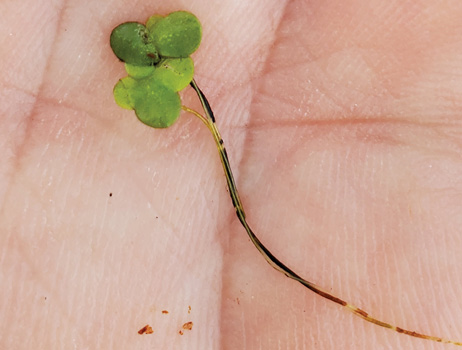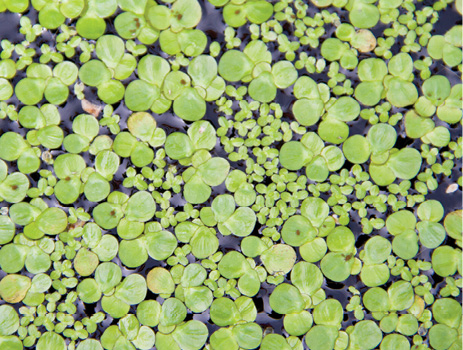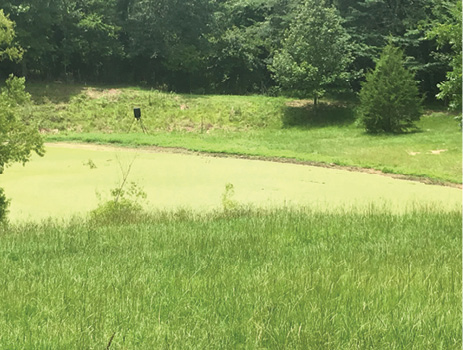Duckweed | Lemna spp.
Floating | Native



but it can take over larger, nutrient-enriched ponds.
Several species of duckweed can often be found growing together. Common duckweed (L. minor) is found throughout Mississippi. Although a native species to the state, it can be highly invasive and problematic. Duckweed draws nutrients directly from the water; therefore, fertilizing waterbodies that contain duckweed is discouraged.
Common duckweed has one to three leaf-like petals in its body, called a thallus. Thalli petals are pale green, flat, and round to oval. They are about 1/16 to 1/8 inch long. Each plant has a single root that may hang an inch or more below the leaf. Several to many plants may cluster together, forming a floating mat on the water surface.
Another species that might be encountered is giant duckweed (Spirodela polyrhiza), which has larger leaves that are darker and often have a small purple dot on the upper surface.
Duckweed will mix with mosquitofern (Azolla spp.) and watermeal (Wolffia spp.), as these species prefer similar conditions (low flow, high nutrients).
Having some duckweed in very shallow shoreline areas around a pond is normal and no cause for concern. Wind action usually keeps it from taking over. However, when duckweed begins to cover the open water surface, it should be immediately treated. It has the potential to eliminate sunlight to the pond, causing an oxygen depletion that can kill fish.
Management Value
Many species of ducks eat duckweed and are responsible for moving this species between waterbodies. However, because duckweed can quickly cover a pond and block out the sun, it is not recommended for any management purpose.
Recommended Controls
Option 1: Diquat (3.73-pound formulation). For each gallon of water, mix 1.28 ounces diquat and 1.3 ounces non-ionic surfactant. Spray to wet all plants. Do not exceed annual herbicide rate limits as stated on the product label.
Option 2: Flumioxazin (4-pound formulation). For each gallon of water, mix 0.1 ounce flumioxazin and 1.3 ounces non-ionic surfactant. Use a buffering agent when mixing with water with pH greater than 7.0. Spray to wet all plants. Do not exceed annual herbicide rate limits as stated on the product label.
Option 3: Fluridone (4-pound formulation). Fluridone (2.5 ounces per acre-foot of water) should be applied as a submersed injection (application using a wand or hose). Herbicide should be re-applied at the same rate 30 days after initial treatment. Determine pond volume prior to application. Do not exceed annual herbicide rate limits as stated on the product label.
NOTE: Acre-foot = average depth of pond multiplied by pond acreage; average depth is calculated by taking the depth at 20 points across a waterbody and averaging the values.
Fluridone requires a contact time of at least 60 days and is not appropriate for waterbodies with low water retention times.
Read and follow all chemical label instructions, especially the section on the use of personal protection equipment.

The information given here is for educational purposes only. References to commercial products, trade names, or suppliers are made with the understanding that no endorsement is implied and that no discrimination against other products or suppliers is intended.
Publication 3735-42 (POD-11-23)
By Wes Neal, PhD, Extension/Research Professor, Wildlife, Fisheries, and Aquaculture; Dennis Riecke, Fisheries Coordinator, Mississippi Department of Wildlife, Fisheries, and Parks; and Gray Turnage, PhD, Assistant Research/Extension Professor, GeoSystems Research Institute.
The Mississippi State University Extension Service is working to ensure all web content is accessible to all users. If you need assistance accessing any of our content, please email the webteam or call 662-325-2262.



